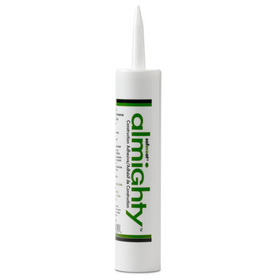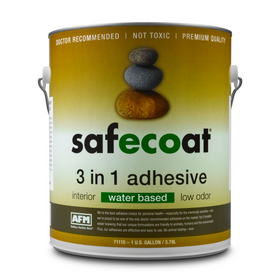
Interior Sealants: For Floors, Counters, and Grout
Last Updated: Feb 11, 2025When purchasing different products for our home's interior and exterior finishing, many product labels will most likely read: "Reseal regularly for optimum performance and durability." Sealants play an essential role in preserving and protecting different elements of our homes. They are critical for sealing our home's building envelope to improve energy efficiency and thermal performance.
Unfortunately, the vast majority of sealant products are made from synthetic chemical materials that can worsen our home's indoor air quality with volatile organic compounds (VOCs). As homeowner's interest in healthier homes has continued to grow, less toxic sealant products are hitting the market. In this in-depth product guide, we dive into what to look for in the best sealants for your home.
Table of Contents
- What Are Interior Sealants?
- Sealant Types
- What Is a Floor Sealant?
- What Is Countertop Sealant?
- What Is Grout Sealant?
- Are Sealants Healthy?
- Are Sealants Environmentally Friendly?
- How Long Do Sealants Last?
- How To Use and Install Sealants?
- What Are The Best Brands of Sealants?
- What Are the Best Brands of Floor Sealant?
- What Are the Best Brands of Countertop Sealant?
- What Are the Best Brands of Grout Sealant?

What Are Interior Sealants?
Interior Sealants refer to products whose primary purpose is to protect and prolong different home building components' lifespan. These sealants are most often made from a polymer-based coating to protect surfaces, including floors and countertops, from aesthetic and structural damage. The wide range of sealant products is often marketed for their specific use or application, such as reducing porosity or preventing mold and mildew growth.
Sealant Types
The specific properties of different types of sealants will depend on several factors, including the medium on which they are applied. For example, a sealant designed for tile grout will probably not work well if you try to seal your floor. Below, we look at some of the most common types of sealants available.

What Is a Floor Sealant?
Many different types of natural flooring alternatives need to be sealed to avoid damage from stains. In most cases, flooring sealant is a chemical solution applied to natural flooring materials such as cork flooring, stone flooring, sandstone, or brick flooring. The seal is formed by a chemical solution that soaks into the porous material and clogs those pores so that stains cannot occur. In most cases, these types of sealants are applied immediately after installation.
It is crucial to differentiate floor sealants from floor finishes, which are routinely applied to wood floors. Whereas floor finishes only create a thin protective layer on the flooring material's topcoat, a flooring sealant offers more substantial protection through clogging the pores themselves. Today, it is possible to find flooring sealant products that provide both a sealant and finishing, leading to a glossier appearance.

All flooring sealant products are either polyurethane, water-based, or solvent-based. As a general rule of thumb, water-based products will be much more environmentally friendly and tend to have less off-gassing. Polyurethane products will offer the most durable sealant. In contrast, solvent-based products will most negatively affect your indoor air quality. They should only be applied in well-ventilated areas when other, less harmful options are not available or viable.

What Is Countertop Sealant?
Today, you can find a wide range of countertops for your kitchen, including marble, quartz, and even recycled paper countertops. However, all of these countertop options are prone to scratching and stains. Some composite countertops include strong resins that reduce the likelihood of damage. Still, almost every kitchen countertop will require regular sealing to avoid liquid and stains damage that can penetrate the surface. Kitchen countertop sealants include resins that are considered to be food-grade safe once dried. Though they can contribute to VOCs within your home, the resins that penetrate the individual pores of your countertop will not react with the foods you prepare.

What Is Grout Sealant?
Homeowners can find sealants specifically designed to protect against water infiltration in the grout between the tiles used in showers, bathrooms, and other water-prone areas of the home. Though ceramic and porcelain tiles are almost entirely waterproof, the grout between the tiles is not. Without proper sealing, water can penetrate beneath the tile leading to mold growth and potentially ruining the wood or studs beneath the tile.

Are Sealants Healthy?
Sealants certainly play an essential role in protecting different home elements from air leaks, water damage, stains, and everything in between. Unfortunately, the sealants we use in our homes have often been one of the leading sources of harmful VOCs. The Environmental Working Group (EWG) has determined that many sealant products include large amounts of formaldehyde, a known carcinogen. Others still include ingredients like BPA and phthalates that can disrupt hormones. In addition, the EPA finds that high levels of VOCs in homes can lead to many serious health issues. These adverse effects can include headaches, eye, nose, throat irritation, and even long-term damage to your liver and kidneys.
Does that mean that we have to choose between protecting our new kitchen countertop from stains or scratches and breathing VOC-free air? Not necessarily. As homeowners continue to demand healthier home building products, many companies are beginning to offer low VOC and VOC-free sealant products. For some applications, you might even be able to make your natural sealants that are 100 percent natural and free from VOCs. For example, it is entirely possible to make your grout sealant by mixing mineral oil and beeswax diluted in a base of linseed oil.

Are Sealants Environmentally Friendly?
Besides the potentially dangerous health effects outlined above, many types of sealants can cause damage to the environment. The off-gassing from volatile organic compounds can lead to photochemical reactions in the atmosphere. These reactions can increase the levels of smog and other contaminants in densely populated urban areas. Perhaps even more worrisome is that some sealant products made from epoxy resins might contain trace levels of bisphenol A (BPA) in the finished product. BPA is highly damaging to human health. It has been shown to negatively affect the growth, reproduction, and development of fish and other aquatic organisms.
Opting for water-based sealants is almost always the most environmentally friendly option. These products will not contain any epoxy resin or traces of BPA. And, choosing low-VOC brands is better for both your health and the health of the natural environment.
How Long Do Sealants Last?
The amount of time a specific sealant lasts will depend on its location, the amount of use the surface receives, and proper installation techniques. For example, kitchen countertops will generally need to be resealed every 3-5 years. Marble countertops, which are much porous than granite countertops, will generally need to be resealed more often. Similarly, floor sealant and grout sealant will need to be resealed every five years, depending on the amount of use and wear and tear the floor or tile receives.
Sealants are very susceptible to damage from UV rays from the sun. Thus, a wood floor that receives large amounts of direct afternoon sun will most likely need to be resealed more often than a floor located in a darker room with less sunlight exposure.
How To Use and Install Sealants?
Most sealants are easy to use and apply. For sealants applied on the surface of home elements such as tile, wood flooring, or countertops, you will need to follow the specific directions for each product. For flooring, a weighted, cylindrical foam applicator can help to apply the sealant evenly. In the case of kitchen countertops, you will want to make sure that the sealant properly penetrates the surface's pores before mopping up any excess sealant.
What Are The Best Brands of Sealants?
Several brands specialize in non-toxic, low-VOC sealants made mostly from natural ingredients. Below, we offer a few suggestions for the best brands providing healthy home sealants for different uses.

What Are the Best Brands of Floor Sealant?
- AFM Safecoat Polyureseal BP wood and floor sealant: This floor sealant has extremely low VOCs and is formaldehyde-free.
- Ecos Wood Shield Stain: This water-based and zero-VOC wood sealant without glycols. It doesn't have VOCs in the pigments, allowing you to add some color to your finished wood flooring.
- OSMO Polyx Oil – This no-VOC, benzene-free sealant is water-repellent and stain-resistant. It works well for cork floors as well.

What Are the Best Brands of Countertop Sealant?
- Real Milk Paint Soapstone Sealer: This company is known for making natural, VOC-free milk paints for your home's interior walls. In addition, they offer an excellent countertop sealant made from walnut oil and carnauba wax flakes for an all-natural countertop finish.
- Waterborne Dense Stone Sealer by DryTreat (formerly Meta Crème): Though this product is synthetic, it is exceptionally low-VOC and low odor for homeowners.

What Are the Best Brands of Grout Sealant?
- Eco Procote Acri-Soy: This bio-based penetrating sealer can be used on virtually any porous surface, including tile grout. Their bio-based dispersion resins and solvent-free water-based modified acrylics are incredibly durable and environmentally friendly.
- Seal-It-Green Tile Grout Sealer: Seal-It-Green is another company with a vast inventory of healthy and environmentally friendly sealant products. Their grout sealant can be applied to the tile and other countertops and comes in an easy-to-use spray bottle.
Tobias Roberts
Tobias runs an agroecology farm and a natural building collective in the mountains of El Salvador. He specializes in earthen construction methods and uses permaculture design methods to integrate structures into the sustainability of the landscape.


